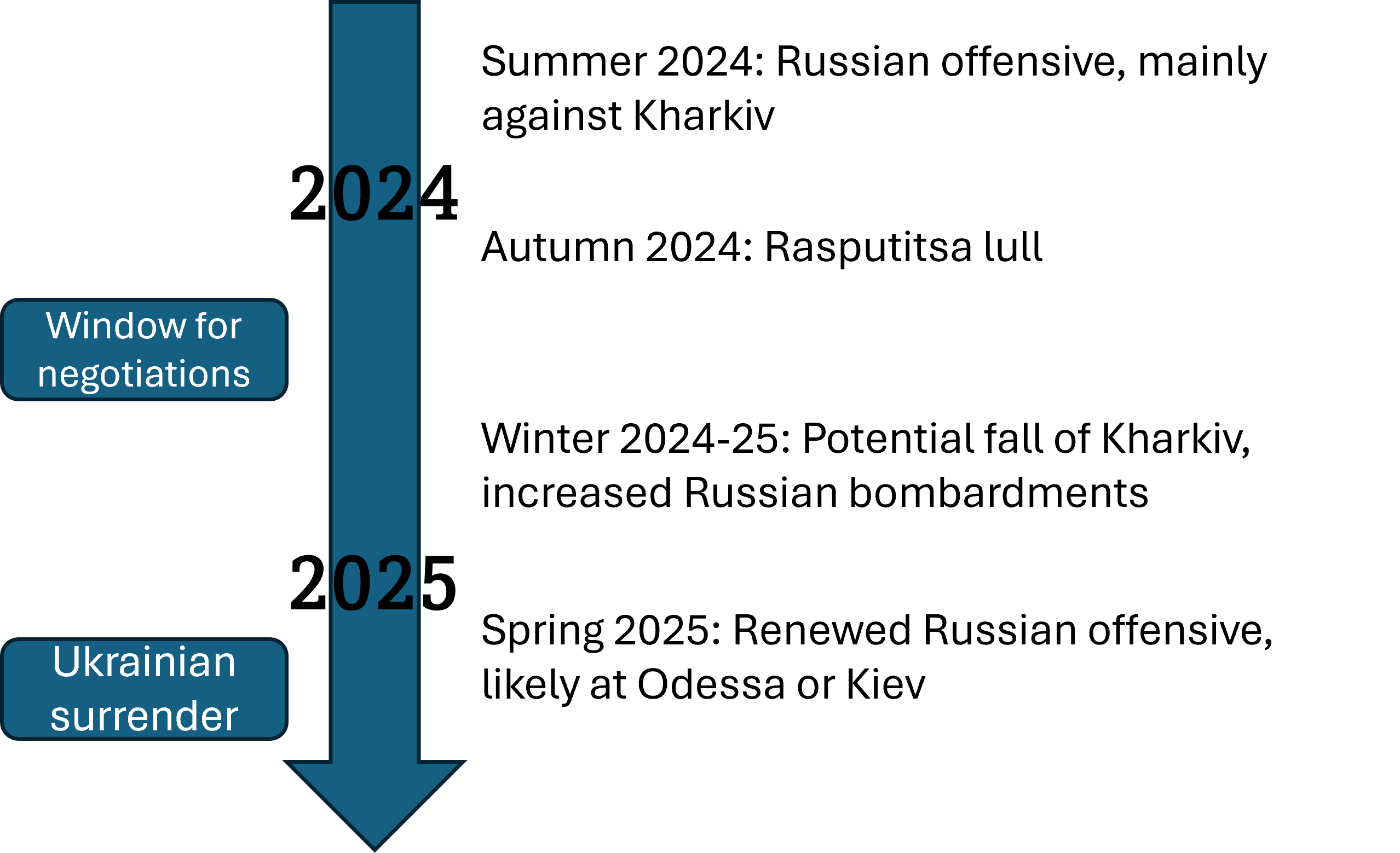Great Game: Despite New Aid, Ukraine will lose within 12 months. Plan Accordingly!

With all eyes on the Middle East for the past weeks and months, we haven’t focused as much on the ongoing war in Ukraine. In the big picture, not much has changes on the frontline despite continued heavy losses and a Russian election. But now I think it’s time for investors to re-adjust their assessment of the war and consider contingencies for the path ahead.
Overall assessment
Ukraine’s ability to hold off Russian attacks is slowly degrading due to ammunition shortages and emerging Russian air superiority. Ukraine’s startegy of bleeding Russia dry has failed completely and Russia is now threating to take the city of Kharkiv and cutting through to the Dniepr River (or even cross it).
The new wave of US aid will be a huge boost to Ukraine’s war effort as it enables the US military to unleash weapons caches across Europe. However, this will not put Ukraine in a position to push Russia back – only prolong the war and perhaps giving Ukraine and the West a window for negotiations. Meanwhile, Russia has shifted it’s economy to war footing and has good control over it’s home front. Russia is well prepared for a long war and are looking to win it.
All in all, I don’t expect Ukraine to last more than 12 months. We’ll get back to how Ukraine might surrender and how you can plan accordingly as an investor.
How did we end up here?
6 months ago, my assessment of Ukraine’s situation was less dire. I expected Ukraine to regain the initiative after the Russian winter offensive and my prediction was for more equal negotiations to begin within 2024. What has changed since then? First of all, Ukraine has not received new waves of US armamanets and financial aid to the level that we had come to expect.
As a consequence, Ukraine is seeing more and more ammunition shortages, which is heavily affecting their frontline performance and durability. This was a key factor in Ukraine’s inability to hold the city of Avdiivka, and we’re hearing similar reports from across the frontline. Back in late 2023, I described the “pendulum of initiative”, which should have swung back in Ukraine’s favor as we approach the summer of 2024. The thing is – it hasn’t. The initiative is firmly Russia’s now and we’re not even talking about Ukrainian offensives anymore. The breaking of the “pendulum of initiative” is usually the point where one part starts to consider their situation thoroughly and begin to have internal discussions on whether the war is winnable.

To make matters worse, Russia is slowly gaining air superiority. I have repeatedly mentioned lack of air superiority as the main problem in Ukraine’s offensive aspirations and similarly so for the Russians. Therefore, if the Russians can keep building air superiority, things could quickly turn very dire for Ukraine. US aid will be critical in holding off Russian air offensives, but right now Ukraine is growing increasingly powerless due to a lack of munitions for anti-aircraft systems. Air superiority is so critical because it would allow the Russians to prepare ground offensives and enable them to start true mobile offensives with the potential of encircling Ukrainian positions or cities entirely.
Finally, the Russian home front seem exceptionally stable. The Prigozhin situation was dealt with and the Russian elections are now behind us. Putin has even gotten rid of Alexei Navalny, so his power is unquestioned and the Russian society has now been mobilized for a prolonged war effort. Russia is ready to fight for years and is getting huge amounts of equipment from especially North Korea, who are currently outproducing the West.
What’s the timeline
Now, remember that this is just a prognosis. A thousand things can go differently from what I expect and it’s almost impossible to predict how a war is going to turn out. Nevertheless, for serious investors, it’s always prudent to assess situations and prepare for likely scenarios. So remember that this is a very speculative potential timeline meant to illustrate our thinking right now:

If my assessment of the situation on the ground holds, my expectation is that Russia will push as hard as they can in the coming summer season before the renewed US aid kicks in. Russia will likely target their offensive at the city of Kharkiv which would open Northwestern Ukraine and enable Russia to push for the Dniepr River just east of Kiev. The Ukrainians are of course well-prepared for this, so the question is whether Russia can manage to encircle Kharkiv or whether it will turn into a bloody house-by-house battle like Bakhmut one year ago. The outcome of that Russian summer offensive will dictate whether there is a window for negotiations in the autumn, where fighting usually slows down a bit due to muddy roads. If Ukraine can hold off the Russians, they might have a window to strike a good peace deal – if not, Russia will have no incentive to compromise and will fight on to a potential Ukrainian surrender in 2025 after renewed offensives. I expect Zelensky’s threshold to be the imminent fall of Kiev and/or Odessa. If Russia lines up for a major attack against those cities, the was is close to being lost and the collective West will have to either intervene directly or push Zelensky to the negotiation table.
A final reason for my estimation is the effect of the US presidential election, which might happen right in the middle of major Russian offensives. Both candidates will be under heavy pressure to get the US out of the Ukraine debacle and especially Donald Trump will likely push for a quick resolution so he can divert his focus to other matters. This increases the likelihood of Ukraine being forced to the negotiation table within 12 months – even if they perform better than I expect on the battlefield.
How will the war end?
Across the West, many leaders must be wishing that they could roll time back to late March 2022 and the negotiations in Istanbul. Russia was in a very bad position and a truce was all but agreed upon. Back then, the Western leaders were optimistic that Ukraine could turn the tide of the war and push Russia back, so the peace negotiations never amounted to more than talks.
Now, Russia is in an entirely position. They are prepared for a long war and have seen next to no geographic losses over the past 18 months. If they can succeed with one or two major offensives, they will have very little incentive to strike a bargain or reach a compromise. Russia will insist on 1) recognition of Crimea as Russian, 2) pseudo-independence for Eastern Ukraine and 3) no NATO membership for Ukraine. Essentially, Russia will either demand a partition of Ukraine into a Western and an Eastern part or the complete neutrality for a more or less intact Ukrainian state. This is almost incomprehensible for Western leaders, who are still talking about how Ukraine might enter the EU once the Russians are driven out. That’s very far from reality and hopefully Western leaders are beginning to prepare for how to protect a neutral Ukraine or how to incorporate a much smaller Ukrainian state into the Western institutions.
How should investors prepare for this?
The US Congress has passed major new aid for Ukraine, but it might be to late. Here’s our assessment and thoughts on how you can prepare for when Ukraine loses


0 Comments